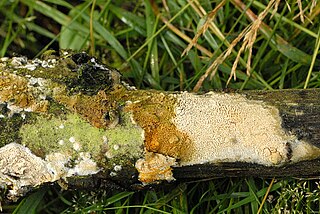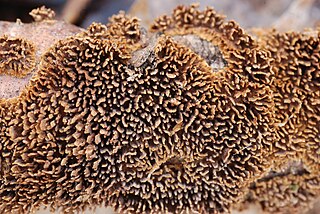Related Research Articles

The Hymenochaetales are an order of fungi in the class Agaricomycetes. The order in its current sense is based on molecular research and not on any unifying morphological characteristics. According to one 2008 estimate, the Hymenochaetales contain around 600 species worldwide, mostly corticioid fungi and poroid fungi, but also including several clavarioid fungi and agarics. Species of economic importance include wood decay fungi in the genera Phellinus and Inonotus sensu lato, some of which may cause losses in forestry. Therapeutic properties are claimed for Inonotus obliquus ("chaga") and Phellinus linteus, both of which are now commercially marketed.

Gyroflexus is a monotypic genus with a yellowish-ivory colored omphalinoid agaric in the Hymenochaetales that grows on living Sphagnum Phylogenetically related agarics are in the genera Rickenella, Blasiphalia, Loreleia, Cantharellopsis and Contumyces, as well as the stipitate-stereoid genera Muscinupta and Cotylidia and clavaroid genus, Alloclavaria. Gyroflexus brevibasidiatus, the type, amongst the vaguely omphalinoid genera is distinguished by its small, mammiform pileus, growth on Sphagnum, and lack of cystidia.

Loreleia is a genus of brightly colored agarics in the Hymenochaetales that have an omphalinoid morphology. They inhabit mosses and or liverworts on soil in temperate regions of the Northern Hemisphere. Phylogenetically related agarics are in the genera Contumyces, Gyroflexus, Rickenella, Cantharellopsis and Blasiphalia, as well as the stipitate-stereoid genera Muscinupta and Cotylidia and the clavaroid genus, Alloclavaria. However, the large number of DNA base-pair changes causes a long-branch to form in phylogenetic analyses depicted as cladograms.
Cantharellopsis is a tan- to whitish-colored bryophilous monotypic genus in the Hymenochaetales. The fruit bodies of the single species Cantharellopsis prescotii has a form intermediate between an Omphalina and a chanterelle (Cantharellus) because of its forked, fold-like gills. It inhabits moss on calcareous soils in temperate regions of Europe. Phylogenetically related agarics are in the genera Contumyces, Gyroflexus, Loreleia, Rickenella and Blasiphalia, as well as the stipitate-stereoid genera Muscinupta and Cotylidia and the clavarioid genus, Alloclavaria.

Alloclavaria is a clavarioid genus in the Hymenochaetales recently segregated from Clavaria by molecular analysis. Phylogenetically related fungi are in the agaricoid genera Rickenella, Contumyces, Gyroflexus, Loreleia, Cantharellopsis and Blasiphalia, as well as the stipitate stereoid genera Cotylidia and Muscinupta. The only species as yet placed in Alloclavaria is the type, formerly known as Clavaria purpurea under which name it is often cited or illustrated.. It is suspected, via circumstantial evidence, i.e. habitat, but not proven, that Alloclavaria is mycorrhizal.

Schizoporaceae are a family of fungi in the order Hymenochaetales. These are saprobic, and cause white rots of standing and fallen wood of coniferous and broadleaved trees. According to one 2008 estimate, the family contains 14 genera and 109 species.

The Hymenochaetaceae are a family of fungi in the order Hymenochaetales. The family contains several species that are implicated in many diseases of broad-leaved and coniferous trees, causing heart rot, canker and root diseases, and also esca disease of grapevines. According to a standard reference text, the family contains 27 genera and 487 species.

Hydnochaete is a genus of hydnoid fungi in the family Hymenochaetaceae, order Hymenochaetales. All species are wood-rotting and produce brown to gray effused fruiting bodies. The genus is very close to Hymenochaete and can be considered its hydnoid counterpart.

Phylloporia is a genus of polypore fungi in the family Hymenochaetaceae. A 2012 estimate placed 23 species in the genus; this number was increased to 30 by 2015.

Porodaedalea is a genus of fungi in the family Hymenochaetaceae. The genus was circumscribed by American mycologist William Alphonso Murrill in 1905.

Fuscoporia torulosa is a species of bracket fungus in the genus Fuscoporia, family Hymenochaetaceae. A wood-decay fungus, it causes a white rot of heartwood in dead and living hardwood trees in Europe, and in coniferous trees in North America.

Trichaptum is a genus of poroid fungi. The genus was circumscribed by American mycologist William Alphonso Murrill in 1904. Formerly classified in the family Polyporaceae, several molecular studies have shown that the genus belongs to the order Hymenochaetales.

The hydnoid fungi are a group of fungi in the Basidiomycota with basidiocarps producing spores on pendant, tooth-like or spine-like projections. They are colloquially called tooth fungi. Originally such fungi were referred to the genus Hydnum, but it is now known that not all hydnoid species are closely related.
Repetobasidium is a genus of fungi in the Hymenochaetales. It was circumscribed by Swedish mycologist John Eriksson in 1958.

Sidera is a genus of crust fungi in the order Hymenochaetales. Circumscribed in 2011, the genus is characterized by species that have whitish resupinate fruit bodies, crystal rosettes on specialized hyphae, and sausage-shaped (allantoid) spores.
Cyanotrama is a fungal genus in the Hymenochaetales order. The genus is monotypic, containing the single species Cyanotrama rimosa, widely distributed in western North America. It has also been collected in single occasions in Ethiopia and Iran. The fungus causes a white rot in conifers, especially junipers. C. rimosa was originally named Poria rimos in 1920 by William Alphonso Murrill, and later known as Diplomitoporus rimosus. Molecular work revealed that the species was aligned not with the polyporoid fungi as previously assumed, but rather with the hymenochaetoid fungi, and Cyanotrama was created to contain it. The genus name refers to the strong cyanophilic reaction of the skeletal hyphae, particularly noticeable in the trama.
Phellinopsis is a genus of four species of fungi in the family Hymenochaetaceae. It was newly circumscribed in 2010, containing P. occidentalis and the type species P. conchata. P. junipericola and P. resupinata were added in 2012, and P. asetosa in 2015.
Phellinidium is a genus of fungi in the family Hymenochaetaceae. The genus, circumscribed in 1984, contains three species found in Europe.
Trichaptum perenne is a species of fungus in the order Hymenochaetales. It differs from species in its genus by its perennial and pileate habit, its large pores and dissepiments, and oblong, ellipsoid basidiospores. It was first isolated from China.

Inocutis is a genus of nine species of polypore fungi in the family Hymenochaetaceae.
References
- ↑ Dariusz Karasiński (2013). "Lawrynomyces, a new genus of corticioid fungi in the Hymenochaetales". Acta Mycologica . 48 (1): 5–11. doi: 10.5586/am.2013.001 .